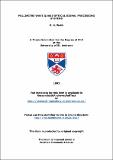Files in this item
An investigation into the function of single-neuron activity in the mesoaccumbens dopamine system of the rat
Item metadata
| dc.contributor.author | Wilson, David Ian Greig | |
| dc.coverage.spatial | 235 | en_US |
| dc.date.accessioned | 2012-06-20T14:06:02Z | |
| dc.date.available | 2012-06-20T14:06:02Z | |
| dc.date.issued | 2005 | |
| dc.identifier.uri | https://hdl.handle.net/10023/2828 | |
| dc.description.abstract | The mesoaccumbens dopamine system has been implicated in many basic psychological processes (e.g. "wanting" and "liking") and illnesses (e.g. addiction, depression, schizophrenia). However, the precise computational functions of nucleus accumbens and dopamine neurons within the system remain unknown. In this thesis, we test some of the current hypotheses regarding the function of this system using a behavioural neurophysiology approach in the rat. The first question we wanted to answer was whether nucleus accumbens neurons process reward-predictive stimuli (e.g. conditioned reinforcers) and reward delivery differently, since previous studies report equivocal findings. To do so, we trained thirsty rats to bar-press on a second-order schedule of saccharin reinforcement, within which the temporal pattern of rats' bar-pressing was reinforced by presentations of a conditioned reinforcer and primary reinforcer (reward). We found that nucleus accumbens neurons typically responded to these conditioned and primary reinforcers with opposite sign, which suggests they were processed differently. We were not sure whether responses to conditioned reinforcers encoded reward-prediction or facilitated a behavioural switch in the rat's behaviour. Indeed, since studies using a variety of experimental techniques have implicated the mesoaccumbens dopamine system in both reward prediction and behavioural switching, we sought to test whether neurons in the nucleus accumbens and dopamine-rich areas of the midbrain respond to outcome-associated stimuli to predict reward or switch behaviour. We found both sets of neurons predominantly did the former. Finally, to understand more about reward consummatory responses from both sets of neurons, we developed a rat behavioural task providing measures of reward "wanting" and "liking". In conclusion, on the basis of our data, the most parsimonious explanation for the function of the mesoaccumbens dopamine system is that it acts to modulate goal-seeking behaviour. Further research is required to identify the function of the interactions between nucleus accumbens and dopamine neurons during goal-seeking and goal consumption. | en_US |
| dc.language.iso | en | en_US |
| dc.publisher | University of St Andrews | |
| dc.rights | Creative Commons Attribution-NonCommercial-NoDerivs 3.0 Unported | |
| dc.rights.uri | http://creativecommons.org/licenses/by-nc-nd/3.0/ | |
| dc.subject.lcc | QP383.2W58 | en_US |
| dc.subject.lcsh | Nucleus accumbens | en_US |
| dc.subject.lcsh | Dopamine | en_US |
| dc.subject.lcsh | Neurophysiology | en_US |
| dc.subject.lcsh | Neurons | en_US |
| dc.title | An investigation into the function of single-neuron activity in the mesoaccumbens dopamine system of the rat | en_US |
| dc.type | Thesis | en_US |
| dc.type.qualificationlevel | Doctoral | en_US |
| dc.type.qualificationname | PhD Doctor of Philosophy | en_US |
| dc.publisher.institution | The University of St Andrews | en_US |
This item appears in the following Collection(s)
Except where otherwise noted within the work, this item's licence for re-use is described as Creative Commons Attribution-NonCommercial-NoDerivs 3.0 Unported
Items in the St Andrews Research Repository are protected by copyright, with all rights reserved, unless otherwise indicated.


